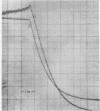Abstract
This paper describes the properties and use of a fiber optic probe as an attachment to a spectrophotometer and its use for measurements in solutions and turbid suspensions. Measurements of a standard were identical when a spectrophotometer equipped with the probe was used or when a spectrophotometer was used in a conventional manner. The probe was calibrated for turbidimetric measurements with microorganisms by relating the apparent absorbancy measured on the spectrophotometer to the dry weight of each species of organism. Continuous measurements were made of the turbidity of growing cultures of Escherichia coli, Streptococcus mutans, and Saccharomyces cerevisiae. Transient changes in cell mass were observed in some cultures during continuous monitoring of growth. The data were recovered in a manner which allowed direct computer processing.
Full text
PDF









Images in this article
Selected References
These references are in PubMed. This may not be the complete list of references from this article.
- BAUCHOP T., ELSDEN S. R. The growth of micro-organisms in relation to their energy supply. J Gen Microbiol. 1960 Dec;23:457–469. doi: 10.1099/00221287-23-3-457. [DOI] [PubMed] [Google Scholar]
- COULTAS M. K., HUTCHISON D. J. Metabolism of resistant mutants of Streptococcus faecalis. IV. Use of a biophotometer in growth-curve studies. J Bacteriol. 1962 Sep;84:393–401. doi: 10.1128/jb.84.3.393-401.1962. [DOI] [PMC free article] [PubMed] [Google Scholar]
- Eisler W. J., Jr, Webb R. B. Electronically controlled continuous culture device. Appl Microbiol. 1968 Sep;16(9):1375–1380. doi: 10.1128/am.16.9.1375-1380.1968. [DOI] [PMC free article] [PubMed] [Google Scholar]
- FORREST W. W., STEPHEN V. A. A SIMPLE RECORDING NEPHELOMETER FOR STUDIES OF BACTERIAL GROWTH. J Sci Instrum. 1965 Aug;42:664–665. doi: 10.1088/0950-7671/42/8/452. [DOI] [PubMed] [Google Scholar]
- HADJIPETROU L. P., STOUTHAMER A. H. AUTOLYSIS OF BACILLUS SUBTILIS BY GLUCOSE DEPLETION. Antonie Van Leeuwenhoek. 1963;29:256–260. doi: 10.1007/BF02046066. [DOI] [PubMed] [Google Scholar]
- Hershey A. D. Factors Limiting Bacterial Growth: IV. The Age of the Parent Culture and the Rate of Growth of Transplants of Escherichia coli. J Bacteriol. 1939 Mar;37(3):285–299. doi: 10.1128/jb.37.3.285-299.1939. [DOI] [PMC free article] [PubMed] [Google Scholar]
- KOCH A. L. Some calculations on the turbidity of mitochondria and bacteria. Biochim Biophys Acta. 1961 Aug 19;51:429–441. doi: 10.1016/0006-3002(61)90599-6. [DOI] [PubMed] [Google Scholar]
- Koch A. L., Ehrenfeld E. Th size and shape of bacteria by light scattering measurements. Biochim Biophys Acta. 1968 Sep 3;165(2):262–273. doi: 10.1016/0304-4165(68)90054-8. [DOI] [PubMed] [Google Scholar]
- Koch A. L. Theory of the angular dependence of light scattered by bacteria and similar-sized biological objects. J Theor Biol. 1968 Jan;18(1):133–156. doi: 10.1016/0022-5193(68)90174-4. [DOI] [PubMed] [Google Scholar]
- Longsworth L. G. The Estimation of Bacterial Populations with the Aid of a Photoelectric Densitometer. J Bacteriol. 1936 Sep;32(3):307–328. doi: 10.1128/jb.32.3.307-328.1936. [DOI] [PMC free article] [PubMed] [Google Scholar]
- POWELL E. O., STOWARD P. J. A photometric method for following changes in length of bacteria. J Gen Microbiol. 1962 Mar;27:489–500. doi: 10.1099/00221287-27-3-489. [DOI] [PubMed] [Google Scholar]
- Tanzer J. M., Krichevsky M. I., Keyes P. H. The metabolic fate of glucose catabolized by a washed stationary phase caries-conducive streptococcus. Caries Res. 1969;3(2):167–177. doi: 10.1159/000259580. [DOI] [PubMed] [Google Scholar]




